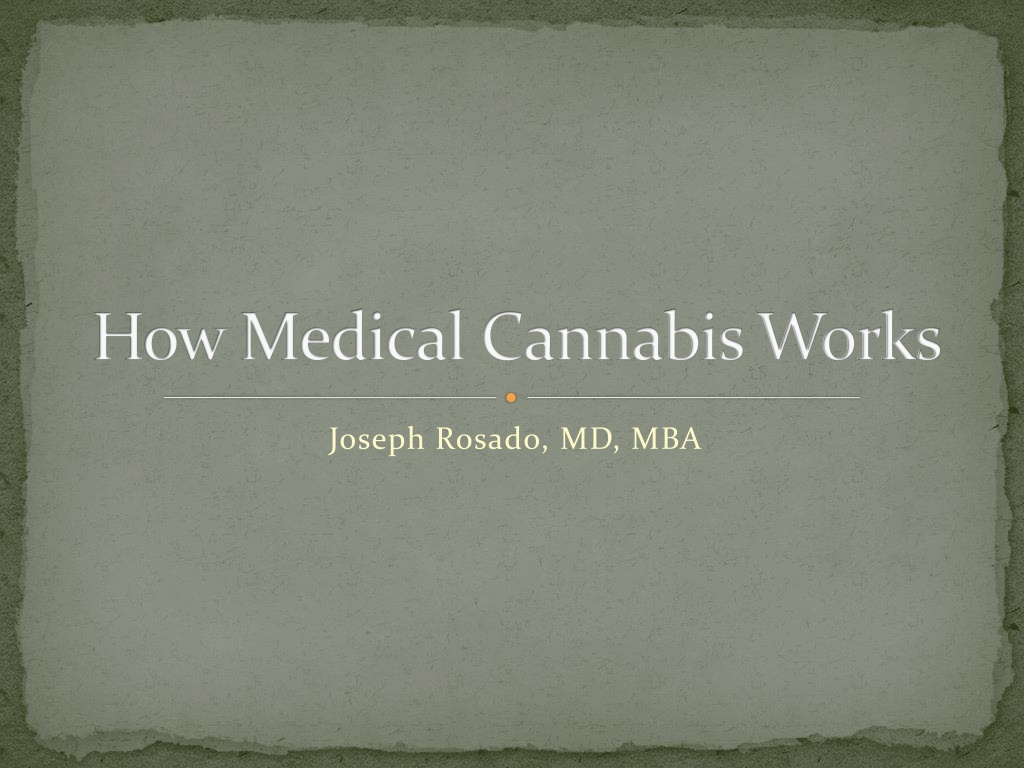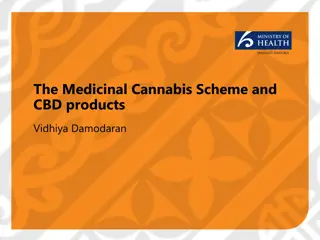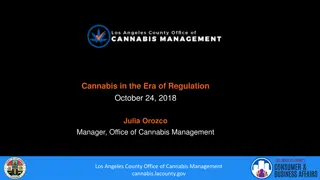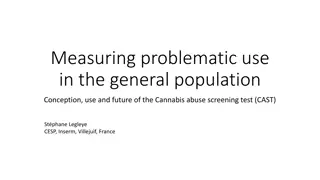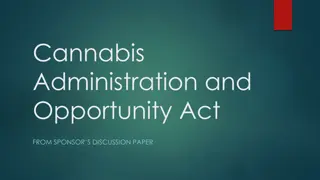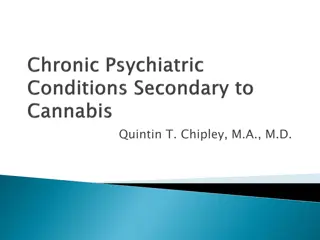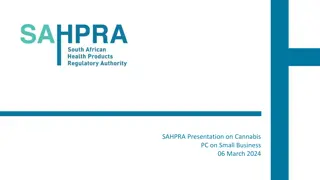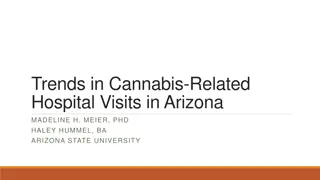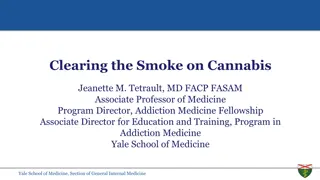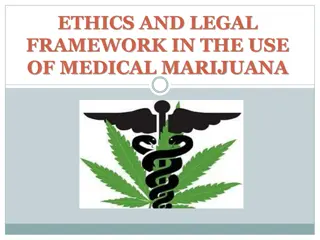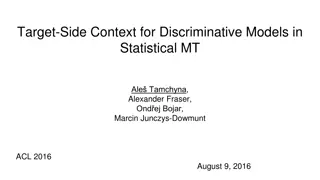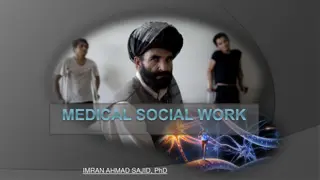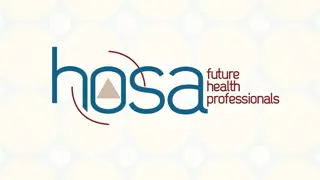Understanding Medical Cannabis: How It Works and Its Historical Context
Medical cannabis, a topic of growing interest, has a complex history in the United States dating back to the mid-1800s. Despite legal and social challenges, it has gained acceptance for therapeutic use, with various states legalizing it for medical purposes. This article delves into the mechanisms of medical cannabis, the Endocannabinoid System, pharmacokinetics of cannabinoids, dosing considerations, and the evolving legal landscape surrounding its use.
Download Presentation

Please find below an Image/Link to download the presentation.
The content on the website is provided AS IS for your information and personal use only. It may not be sold, licensed, or shared on other websites without obtaining consent from the author. Download presentation by click this link. If you encounter any issues during the download, it is possible that the publisher has removed the file from their server.
E N D
Presentation Transcript
How Medical Cannabis Works Joseph Rosado, MD, MBA
How many of you have seen these Medical Headlines ? Efficacy of Cannabinoid Agonists in Managing Pain. By Florence Chaverneff, Ph.D., Clinical Pain Advisor, 11/8/16 Medical Cannabis - Harmful or Beneficial by Medical Headlines, MDLinx, 01/15/2017 Cannabis use and age at first-episode psychosis. Psychiatry Research, 01/27/2017, Mane A, et al.
MAY I TELL YOU A LITTLE ABOUT MYSELF? Primary care physician in the state of FL An advocate for the medicinal use of cannabis in the state of FL Participated with the United For Care campaign during the 2014 and 2016 elections Have completed the 8-hour course on recommending high CBD/low THC Have completed the 2-hour medical director course Have recommended low THC and Medical Cannabis to over 40 patients and have over 100 patients in the pipeline .
Objectives Recall the history of therapeutic cannabis use. Review Terminology Outline the function of the Endocannabinoid System (ECS). Review the Pharmacokinetics of cannabinoids. Review dosing, side effects and dosing challenges of medical cannabis use. Review the state of Florida s Amendment 2. Analyze the pharmacology of exogenous cannabinoids in clinical use.
Introduction Cannabis was introduced to the United States as a medicinal product in the mid-1800s AND was widely prescribed by physicians as a therapeutic until 1937, when sanctions were levied against medical or recreational use and physician prescribing aka the Marijuana Tax Act. http://time.com/4298038/marijuana-history-in- america/
Introduction, cont. Prohibition culminated in 1970 with the passage of the Controlled Substance Act, which formalized the criminalization of marijuana possession or use, regardless of quantity or context. http://www.fda.gov/regulatoryinformation/legislation/u cm148726.htm
Introduction, cont. Despite its illegal status, public DEMAND for medical access led to the legalization of cannabis for medical use in California in 1996 and as of 2016, voters in an additional 27 states and the District of Columbia have followed suit. https://moneymorning.com/2016/11/09/map-states-legalizing-marijuana-in-2017/
Introduction, cont. Despite substantial progress in the scientific understanding of cannabis mechanisms and the available outcomes of rigorously designed Randomized Clinical Trials (RCTs), this information is not reaching the public and to a lesser extent, healthcare providers who practice in states legally permitting medical cannabis use. Ware MA. The Educational Needs of Physicians Regarding Cannabis and Cannabinoids. Available at http://www.cannabis- med.org/meeting/Cologne2013/reader.pdf.
Important Terms The following terms are used often in discussions of medical cannabis use, and these definitions may help clarify the issues described during this presentation. Marijuana Cannabis Cannabinoid Cannabidiol Tetrahydrocannabinol
Marijuana Is a slang term for cannabis. Cannabis is its actual name. Cannabis is the genus that contains the three psychoactive plants we love so well: Cannabis sativa, Cannabis indica, and their stubby cousin Cannabis ruderalis. However, cannabis is far more commonly referred to as marijuana. Why? The term "marijuana" came to the United States via Mexico. "The word marijuana, together with the use of herbal cannabis as an intoxicant, is consistently identified as coming into the USA from Mexico, being brought there by migrant workers. This terminology distanced the plant as much as possible from its common medical and industrial uses, where it was more often referred to as cannabis or hemp. Using "marijuana," most commonly associated with recreational use among poor Mexican immigrants , was a sneaky bit of branding for the bill Harry Anslinger, the head of the then brand-new Federal Bureau of Narcotics wanted passed which in 1937 became the Marijuana Tax Act. http://www.thestranger.com/news/2016/04/13/23948555/the-word-marijuana- versus-the-word-cannabis
Cannabis Derived from Cannabis sativa, the proper name of the marijuana plant. www.wikipedia.com
Cannabinoid One of a class of diverse chemical compounds that acts on cannabinoid receptors in cells that alter neurotransmitter release in the brain. Ligands for these receptor proteins include the endocannabinoids (produced naturally in the body by animals), the phytocannabinoids (found in cannabis and some other plants), and synthetic cannabinoids (manufactured artificially). www.wikipedia.com
Cannabidiol and Tetrahydrocannabinol Cannabidiol Tetrahydrocannabinol Or, CBD is one of at least 113 activecannabinoids identified in cannabis. Or THC, or more precisely its main isomer ( )-trans- 9- tetrahydrocannabinol. It is a major phytocannabinoid, accounting for up to 40% of the plant s extract. Is the principal psychoactive constituent (or cannabinoid) of cannabis. CBD is considered to have a wide scope of potential medical applications.
The EndocannabinoidSystem (ECS) The ECS was discovered by Dr. Ralph Mechoulam being a pioneer in this area in the mid-1960 s. Endocannabinoids are found throughout the body and we share this system in common with all other vertebrate animals, and some invertebrate animals . The main ECS receptors are CB1 and CB2. Sulak, D. (2015). Introduction to the endocannabinoid system. Retrieved fromhttp://norml.org/library/item/introduction-to-the- endocannabinoid-system.
What are Endogenous Cannabinoids? These are the chemicals our own bodies make to naturally stimulate the cannabinoid receptors (CB1 and CB2). Anandamide and 2-arachidonoylglycerol (2-AG) are two well known endocannabinoids. (1) The body produces these endocannabinoids in a similar fashion to how it produces endorphins (2), and activities such as exercise support the endogenous production of cannabinoids. 1. Sulak, D. (2015). Introduction to the endocannabinoid system. Retrieved fromhttp://norml.org/library/item/introduction-to-the- endocannabinoid-system. 2. Pfrommer, R. (2015). A beginner s guide to the endocannabinoid system: The reason our bodies so easily process cannabis. Retrieved fromhttp://reset.me/story/beginners-guide-to-the- endocannabinoid-system/.
CB2 Receptors Are primarily found in the: Peripheral Nervous System (PNS) In the immune system: B cells, Natural Killer Cells, Monocytes, Polymorphonuclear Neutrophilsand T cells
Mechanisms of Action: Shared The Endocannabinoid System alters CB1 or CB2 receptor expressions during stress response, which is beneficial in some pathologic states, i.e., neuropathic pain and multiple sclerosis, because increased CB expression may lessen symptoms or disease progression and provide a protective role. Miller LK, Devi LA. The highs and lows of cannabinoid receptor expression in disease: mechanisms and their therapeutic implications. Pharmacol Rev. 2011;63(3):461-470.
PHARMACOKINETICS OF CANNABINOIDS Smoked A typical cannabis cigarette aka joint consists of approximately 0.5 to 1 gram of cannabis and the THC content is approximately 4% or 20 mg to 40 mg, respectively. About 50% of the THC in a joint of herbal cannabis is inhaled in the mainstream smoke; nearly all of this is absorbed through the lungs, rapidly enters the bloodstream and reaches the brain within minutes. Maximal effect is experienced after 30 minutes and the effect lasts 2-3 hours. Peak plasma THC occurs within 10 minutes and decreases to roughly 60% of peak by 15 minutes and to 20% of peak by 30 minutes. This rapid onset and predictable decay allows for effective dose titration NOT possible with oral cannabinoids. Aggarwal SK. Cannabinergic pain medicine: a concise clinical primer and survey of randomized-controlled trial results. Clin J Pain. 2013;29(2):162-71. Grant I, Atkinson JH, Gouaux B, Wilsey B. Medical marijuana: clearing away the smoke. Open Neurol. 2012;6:18-25.
PHARMACOKINETICS OF CANNABINOIDS Smoked, cont. Once absorbed, THC and other cannabinoids are rapidly distributed to all other tissues at rates dependent on the blood flow (see figure). Because they are extremely lipid soluble, cannabinoids accumulate in fatty tissues, reaching peak concentrations in 4-5 days. They are then slowly released back into other body compartments, including the brain. Because of the sequestration in fat, the tissue elimination half-life of THC is about 7 days, and complete elimination of a single dose may take up to 30 days. Maykut, M. O. (1985) Health consequences of acute and chronic marijuana use. Progress in Neuropsychopharmacology and Biological Psychiatry, 9, 209-238.
PHARMACOKINETICS OF CANNABINOIDS--Vaporized In comparing smoked v. vaporized administration (what is allowed in the state of FL), a study found higher serum THC at 30 minutes and 60 minutes post-inhalation with vaporization and comparable serum THC levels over the remaining 6 hour period. Also, vaporization was preferred by 80% of the subjects in the study. And, as with smoking, vaporization was highly conducive to self- titration. Abrams DI, Vizoso HP, Shade SB, Jay C, Kelly ME, Benowitz NL. Vaporization as a smokeless cannabis delivery system: a pilot study. Clin Pharmacol Ther. 2007;82(5):572-578. Hazekamp A, Ruhaak R, Zuurman L, et al. Evaluation of a vaporizing device (Volcano) for the pulmonary administration of tetrahydrocannabinol. J Pharm Sci. 2006;95(6):1308-1317.
PHARMACOKINETICS OF CANNABINOIDS Oral Ingestion The bioavailability after oral ingestion, however, is much less; blood concentrations reached are 25-30% of those obtained by smoking the same dose, partly because of first-pass metabolism in the liver (see Drug-Drug Interaction below). The onset of effect is delayed (0.5-2 hours) but the duration is prolonged because of continued slow absorption from the gut. Agurell, S., Halldin, M., Lindgren, J.-E., et al (1986) Pharmacokinetics and metabolism of 1-tetrahydrocannabinol and other cannabinoids with emphasis on man. Pharmacological Reviews, 38, 21-43. Maykut, M. O. (1985) Health consequences of acute and chronic marijuana use. Progress in Neuropsychopharmacology and Biological Psychiatry, 9, 209-238.
PHARMACOKINETICS OF CANNABINOIDS Oro-mucosal Following a single oro-mucosal administration (four sprays totaling 10.8 mg 9-THC and 10 mg CBD), the mean peak plasma concentrations of both THC and CBD typically occur within 2 - 4 hours. When administered oro-mucosally, blood levels of 9-THC and other cannabinoids are lower than those achieved by inhalation of the same dose of smoked/vaped cannabis, but 9-THC blood levels were comparable to those seen with oral administrations. GW Pharmaceuticals. Sativex Product Monograph. 2010. Karschner, E. L., Darwin, W. D., Goodwin, R. S., Wright, S. and others. (2011). Plasma cannabinoid pharmacokinetics following controlled oral delta9- tetrahydrocannabinol and oromucosal cannabis extract administration. Clin.Chem. 57: 66-75.
PHARMACOKINETICS OF CANNABINOIDS Rectal While 9-THC itself is not absorbed through the rectal route, the pro-drug 9-THC-hemisuccinate is absorbed; this fact, combined with decreased first-pass metabolism through the rectal route, results in a higher bioavailability of 9-THC by the rectal route (52 - 61%) than by the oral route. Brenneisen, R., Egli, A., Elsohly, M. A., Henn, V. and others. (1996). The effect of orally and rectally administered delta 9- tetrahydrocannabinol on spasticity: a pilot study with 2 patients. Int.J.Clin.Pharmacol.Ther. 34: 446-452. R. D., Shaw, L. M., Edling-Owens, J., Engelman, K. and others. (1993). Bypassing the first-pass effect for the therapeutic use of cannabinoids. Pharmacol.Biochem.Behav. 44: 745-747. Perlin, E., Smith, C. G., Nichols, A. I., Almirez, R. and others. (1985). Disposition and bioavailability of various formulations of tetrahydrocannabinol in the rhesus monkey. J.Pharm.Sci. 74: 171-174. Elsohly, M. A., Little, T. L., Jr., Hikal, A., Harland, E. and others. (1991). Rectal bioavailability of delta-9- tetrahydrocannabinol from various esters. Pharmacol.Biochem.Behav. 40: 497-502. Elsohly, M. A., Stanford, D. F., Harland, E. C., Hikal, A. H. and others. (1991). Rectal bioavailability of delta-9- tetrahydrocannabinol from the hemisuccinate ester in monkeys. J.Pharm.Sci. 80: 942-945.
PHARMACOKINETICS OF CANNABINOIDS Topical Cannabinoids are highly hydrophobic, making transport across the aqueous layer of the skin the rate-limiting step in the diffusion process. No clinical studies exist regarding the percutaneousabsorption of cannabis-containing ointments, creams, or lotions. However, some research has been carried out on transdermal delivery of synthetic and natural cannabinoids using a dermal patch. A patch containing 8 mg of 8-THC yielded a mean steady-state plasma concentration of 4.4 ng/mL 8-THC within 1.4 hours in a guinea pig model, and this concentration was maintained for at least 48 hours. Huestis, M. A. (2007). Human cannabinoid pharmacokinetics. Chem.Biodivers. 4: 1770-1804. Valiveti, S., Hammell, D. C., Earles, D. C., and Stinchcomb, A. L. (2004). Transdermal delivery of the synthetic cannabinoid WIN 55,212-2: in vitro/in vivo correlation. Pharm.Res. 21: 1137-1145. Valiveti, S., Kiptoo, P. K., Hammell, D. C., and Stinchcomb, A. L. (2004). Transdermal permeation of WIN 55,212-2 and CP 55,940 in human skin in vitro. Int.J.Pharm. 278: 173-180.
Drug-Drug Interactions May occur with the oral administration of both THC and CBD due to the First Pass Metabolism also known as the first pass effect or pre-systemic metabolism a phenomenon of drug metabolism whereby the concentration of a drug is greatly reduced before it reaches the systemic circulation.
Dosing While precise dosages have not been established, some "rough" dosing guidelines for vaporized cannabis have been published (see below). Besides vaporization, cannabis is known to be consumed in baked goods such as cookies or brownies, or drunk as teas or infusions. However, absorption of these products by the oral route is slow and erratic, as mentioned previously and the onset of effects is delayed with the effects lasting much longer compared to vaping. Furthermore, dosages for orally administered products are even less well established than for vaporization.
Dosing, continued Dosing remains highly individualized and relies to a great extent on titration. Patients with no prior experience with cannabis and initiating cannabis therapy for the first time are cautioned to begin at a very low dose (0.1 mg/lb for the inexperienced and 0.25 mg/lb for the more experienced) and to stop therapy if unacceptable or undesirable side effects occur. Due to the First Pass Mechanism , the result of the dosage guideline above will need to be doubled for oral ingestion. Carter, G. T., Weydt, P., Kyashna-Tocha, M., and Abrams, D. I. (2004). Medicinal cannabis: rational guidelines for dosing. IDrugs. 7: 464- 470.
Unacceptable or undesirable side effects aka Greening Out Unacceptable or undesirable side effects known as Greening Out can be quite common in people who have not used cannabis, or have used non-medical grade cannabis. The following are the symptoms of too much marijuana in the system: Temporary feelings of paranoia, fear and anxiety Shortness of breath Pupil dilation Vomiting and/or nausea Fast heart rate Shaking that is hard to control, feeling cold Disorientation or hallucinations Hangover This phenomenon passes on its own within minutes to hours of marijuana use.
Dosing Challenges Cannabis has many variables that do not fit well with the typical medical model for drug prescribing; for example: The complex pharmacology of cannabinoids The inter-individual (genetic) differences in cannabinoid receptor structure and function. The inter-individual (genetic) differences in cannabinoid metabolism affecting cannabinoid bioavailability. Pharmacological tolerance to cannabinoids, Changes to cannabinoid receptor distribution/density and/or function as a consequence of a medical disorder. The variable potency of the cannabis plant material. The different dosing regimens and routes of administration used in different research studies all contribute to the difficulty in reporting precise doses or establishing uniform dosing schedules for cannabis and/or cannabinoids.
FL Amendment 2 Conditions The legal language of Amendment 2 was written to explicitly allow medical marijuana to be provided as a treatment for patients with the following specific diseases: Cancer Epilepsy Glaucoma HIV/AIDS Post-Traumatic Stress Disorder (PTSD) Amyotrophic Lateral Sclerosis (ALS) aka Lou Gehrig's Syndrome Crohn's Disease (CD) Parkinson's Disease (PD) Multiple Sclerosis (MS)
How Medical Cannabis Works for Cancer Nausea and Vomiting Cannabis may be best known for its ability to reduce nausea and vomiting caused by chemotherapy. It s so effective that a pill form of THC (Marinol) has been approved by the FDA for treating chemotherapy-induced nausea and vomiting since 1985. Weight Loss Along with nausea, patients undergoing chemotherapy often find it hard to maintain normal weight. Cannabis has been shown to not only relieve nausea, but stimulate appetite as well. For patients with cancer, cannabis can help improve food intake and prevent unhealthy loss of weight. Mood Cancer patients often suffer from mood disorders such as depression. While it s no secret that marijuana makes users feel good, research seems to explain why. As many studies have found, chemicals in cannabis appear to have significant anti- anxiety and antidepressanteffects.
How Medical Cannabis Works for Cancer, 2 Pain Another well-known effect of cannabis is pain relief. And while its benefits seem to span a range of chronic pain disorders, studiesshow that cannabis can help reduce pain in cancer as well. Sleep Patients with cancer often suffer from sleep problems, including difficulty falling asleep and maintaining sleep. On the other hand, sleepiness is one of cannabis most commonly reported side effects. THC has also been shown to improve sleep in patients undergoing chemotherapy. Fatigue Cancer-related fatigue can also cause patients to feel sleepy during the day. Interestingly, cannabis seems to help patients combat daytime fatigue, while at the same time helping patients get to sleep at night. It s multi-faceted effect on sleep may depend on the strain of cannabis and the balance of cannabinoids that they contain.
How Medical Cannabis Works for Cancer, 3 Constipation Chemicals in cannabis help regulate the digestive system and have been suggested as a treatment for a wide range of bowel disorders. While cannabis seems to help byreducing bowel movements in inflammatory bowel disorders, it appears to have an opposite effect in constipation. Itching Itching can be a side effect of various cancers as well as various cancer treatments. While the underlying causes of itching in cancer patients vary, cannabis seems to help some patients deal with this irritating symptom. Cancer Perhaps the most promising (and controversial) benefit of cannabis in cancer is the treatment of cancer itself. While preclinical studies have long supported the ability of cannabis to kill cancer cells and stop the disease from spreading, the medical community points out that human research is lacking, none the less, I have seen tumor shrinkage in patients being treated with medical cannabis.
How Medical Cannabis Works for Epilepsy Evidence from laboratory studies, anecdotal reports, and small clinical studies from a number of years ago suggests that cannabidiol, a non- psychoactive compound of cannabis, could potentially be helpful in controlling seizures. In 2012, a literature review of clinical studies on cannabinoids for epilepsy could not give a reliable conclusion about the effectiveness of four randomized controlled trials of cannabidiol (CBD). Yet in the 48 people included in these reports, no side effects were noted. Conducting studies can be difficult as researchers have limited access to cannabis due to federal regulations and even more limited access to cannabidiol (CBD). Individual reports of children with refractory (or intractable) epilepsy who have tried cannabis, usually with high ratios of cannabidiol to THC, have reported marked improvements in seizure frequency, including a report describing the results of Charlotte, a girl with Dravet syndrome.
How Medical Cannabis Works for Epilepsy, 2 Recently, there have been some open-labeled studies in the U.S. of Epidiolex (a drug derived from cannabidiol or CBD), which is produced by a pharmaceutical company (GW Pharmaceuticals). Epidiolex is a purified, 99% oil-based extract of CBD that is produced to give known and consistent amounts in each dose. The U.S. Food and Drug Administration (FDA) has given some epilepsy centers permission to use this drug as "compassionate use" for a limited number of people at each center. Such studies are ongoing for difficult epilepsies such as Lennox-Gastaut syndrome (in children and adults) and Dravet syndrome in children.
How Medical Cannabis Works for Epilepsy, 3 Results from 213 people who received Epidiolex (99% CBD) in an open label study (without a placebo control) were presented at the American Academy of Neurology, April 22, 2015 in Washington DC. Data from 137 people who completed 12 weeks or more on the drug were used to look at how helpful or effective the drug was. People who received the Epidiolex ranged from 2 to 26 years old with an average age of 11. All had epilepsy that did not respond to currently available treatments - 25 or 18% had Dravet Syndrome (DS) and 22 or 16% had Lennox-Gastaut Syndrome (LGS).
How Medical Cannabis Works for Epilepsy, 4 Seizures decreased by an average of 54% in 137 people who completed 12 weeks on Epidiolex. Patients who had DS responded more positively with a 63% decrease in seizures over 3 months. This improvement in seizures lasted through 24 weeks on the Epidiolex, more often for people with DS than without DS. In 27 patients with atonic seizures (which are commonly seen in people with LGS as well as other types of epilepsy), the atonic seizures decreased by 66.7% on average. The responder rate (the number of people whose seizures decreased by at least 50%) was also slightly better in patients with DS (about 55% at 3 months) as compared to patients without DS (50%). People who were also taking the anti-seizure medication Clobazam (Onfi) seemed to respond more favorably to the Epidiolex with a greater improvement in convulsive seizures than in patients who were not taking Clobazam. The authors suggested that an interaction between Clobazam and Epidiolex may play a part in the differences seen. 14 people withdrew from the study because the drug was not effective for them.
How Medical Cannabis Works for Glaucoma The idea that cannabis can be helpful in treating glaucoma dates to the 1970s. Studies conducted then showed that smoking cannabis lowered the Intraocular Pressure (IOP) of people with glaucoma. As a result of this research, additional studies were conducted examining whether cannabis or its active ingredient, THC, could be used to keep IOP lowered. This research was supported by the National Eye Institute, a division of the federal National Institutes of Health. The research found that when cannabis is smoked or when a form of its active ingredient is taken as a pill or by injection, it does lower IOP.
How Medical Cannabis Works for HIV/AIDS While the side effects of HIV and AIDS treatment can impinge on life quality, studies have shown that medical cannabis can help make the adverse effects more manageable. HIV positive patients consuming medical cannabis have reported significant improvements in appetite, muscle pain levels, nausea, anxiety, depression and skin tingling. Studies have found that daily and chronic neuropathic pain related to HIV can be significantly lowered by regular cannabis consumption. Woodridge, E., Barton, S., Samuel, J., Osario, J., Dougherty, A. and Holdcroft, A. (2005, April 20). Cannabis use in HIV for pain and other medical symptoms. Journal of Pain and Symptom Management, 29(4), 358-67. Ellis, R., Toperoff, W. Vaida, F., van den Brande, G., Gonzales, J., Gouaux, B., Bentley, H. and Atkinson, J. (2008, February) Smoked Medicinal Cannabis for Neuropathic Pain in HIV: A Randomized, Crossover Clinical Trial. Neuropsychopharmacology. 34(3), 672-680. Abrams, DI., Jay, CA., Shade, SB., Vizoso, H., Reda, H., Press, S., Kelly, ME., Rowbotham, MC. and Petersen, KL. (2007, February). Cannabis in painful HIV-associated sensory neuropathy: a randomized placebo-controlled trial. Neurology,68(7), 515-21.
How Medical Cannabis Works for HIV/AIDS, 2 Medical cannabis also boosts appetite and daily functioning, helping to combat weight loss and muscle breakdown. Research also suggests that consuming medical cannabis is safe for patients with HIV/AIDS. One study found no significant association with cannabis use and the CD4 T-cell count of patients co-infected with HIV and HCV, which means medical marijuana had no adverse effects on the immune system. Haney, M., Rabkin, J., Gunderson, E. and Foltin, RW. (2005, August). Dronabinol and marijuana in HIV(+) marijuana smokers: acute effects on caloric intake and mood. Psychopharmacology, 181(1), 170-8. Marcellin, F., Lions, C., Rosenthal, E., Roux, P., Sogni, P., Wittkop, L., Protopopescu, C., Spire, B., Salmon-Ceron, D., Dabis, F., Carrieri, M.P., for the HEPAVIH ANRS CO13 Study Group. (2016, April 13). No significant effect of cannabis use on the count and percentage of circulating CD4 T-cells in HIV- HCV co-infected patients (ANRS CO13-HEPAVIH French cohort). Drug and Alcohol Review, doi: 10.1111/dar.12398.
How Medical Cannabis Works for HIV/AIDS, 3 While research surrounding cannabis potential treatment effects on the HIV virus itself, a recent study discovered that cannabis-like compounds blocked the spread of HIV virus during the infection s late stages. Results from an animal trial also suggest that marijuana might be able to stop the spread of HIV. Monkeys that were infected with an animal form of the virus and administered with THC for 17 months saw a decrease in damage to the immune tissue of the stomach. Costantino, CM., Gupta, A., Yewdall, A., Dale, B., Devi, L. and Chen, B. (2012) Cannabinoid Receptor 2-Mediated Attentuation of CXCR4-Tropic HIV Infection in Primary CD4+ T Cells. PLoS One, 7(3), e33961. Molina, P. E., Amedee, A. M., LeCapitaine, N. J., Zabaleta, J., Mohan, M., Winsauer, P. J., Vande Stouwe, C., McGoey, R.R., Auten, M.W., LaMotte, L., Chandra, L.C., and Birke, L. L. (2014). Modulation of Gut-Specific Mechanisms by Chronic 9-Tetrahydrocannabinol Administration in Male Rhesus Macaques Infected with Simian Immunodeficiency Virus: A Systems Biology Analysis. AIDS Research and Human Retroviruses, 30(6), 567 578. http://doi.org/10.1089/aid.2013.0182
How Medical Cannabis Works for PTSD Dr. Raphael Mechoulam, has discussed his experiments demonstrating the neuroprotective effects of the endocannabinoid system in mice that have had traumatic injuries to the brain. Another fascinating discovery, one with implications for PTSD, is that the cannabinoid system is integrally related to memory, specifically to memory extinction. Memory extinction is the normal, healthy process of removing associations from stimuli. Dr. Mechoulam explained that an animal which has been administered an electric shock after a certain noise will eventually forget about the shock after the noise appears alone for a few days. Mice without cannabinoid systems simply never forget - they continue to cringe at the noise indefinitely. This has implications for patients with PTSD, who respond to stimuli that remind them of their initial trauma even when it is no longer appropriate. By aiding in memory extinction, cannabis could help patients reduce their association between stimuli (perhaps loud noises or stress) and the traumatic situations in their past.
How Medical Cannabis Works for ALS and MS An article titled, Cannabis Use in Palliative Care, published in the Journal of Clinical Nursing, recounts studies that have explored cannabis as a therapy for ALS patients. Carter and Rosen (2001) and Amtmann et al. (2004) suggested that it may be of use in ALS based on studies of other patient groups, particularly those with MS, for whom cannabis acted as an analgesic, muscle relaxant, bronchodilator, saliva reducer, appetite stimulant, sleep inducer and antidepressant. Carter and Rosen also made the point that emerging evidence suggests cannabis has strong antioxidant and neuroprotective benefits, which may prolong cell survival a key issue for ALS and MS patients, who suffer from the death of motor neuron cells. An online survey conducted by Amtmann found cannabis to be moderately effective in reducing appetite loss, depression, pain, muscular spasticity, drooling and weakness for ALS patients, with the longest relief reported for depression.
How Medical Cannabis Works for PD Researchers have shown enthusiasm to study cannabis in relation to Parkinson's after people with PD gave anecdotal reports and posted on social media as to how cannabis reduced their tremors. Some researchers think that cannabis might be neuroprotective saving neurons from damage caused by Parkinson's. Besides reducing tremor, cannabinoids have also been studied for use in treating other symptoms, like bradykinesia (slowness caused by PD) and dyskinesia (excess movement caused by levodopa one of the medications used to treat PD).
How Medical Cannabis Works for PD, 2 People with PD have less CB1 receptors than people who do not have PD. A boost to the CB1 receptor through an agonist, like cannabis, can improve tremors and may alleviate dyskinesia. Similarly, the other receptor, CB2, is also being studied to determine if it can modify the disease or provide neuroprotective benefits, as with ALS and MS. http://www.parkinson.org/understanding- parkinsons/treatment/complementary- treatment/medical-marijuana-and-parkinsons-disease
Patient Education When you recommend medical cannabis to your patients, he or she must be advised of the potential side effects mentioned earlier. All patients must be monitored for outcomes similar to traditional medical follow up monitoring. Any concomitant medications and drug interactions need to be monitored.
Conclusion Medical cannabis has become a hot topic in health care. The preponderance of information on this subject seems to come from highly visible individuals or groups who either vehemently oppose or passionately advocate therapeutic cannabis. I trust that in this webinar we have provided a dispassionate, evidence-based perspective to all of you.
